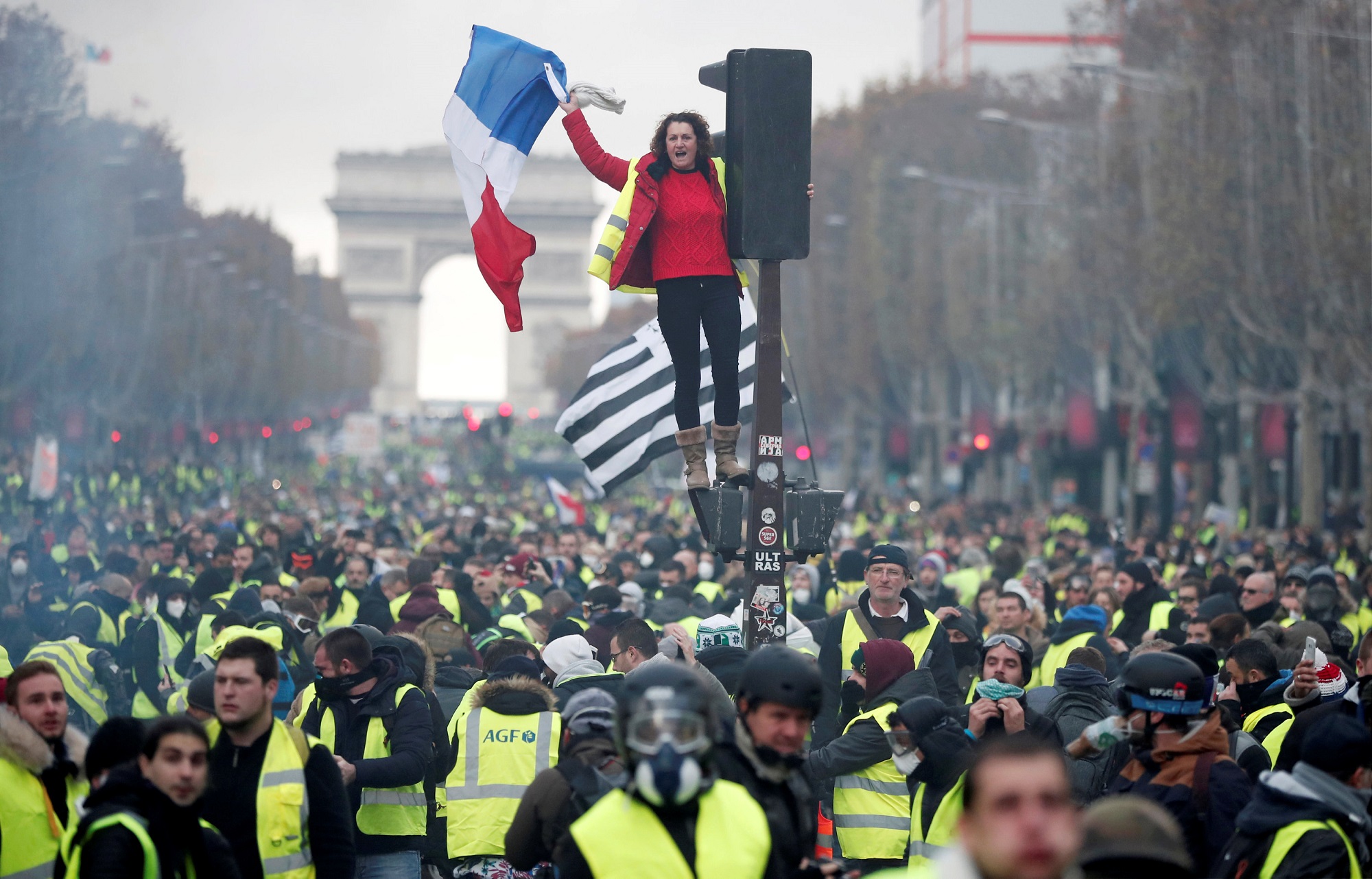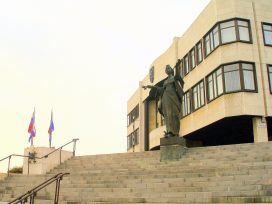The French are used to sudden large-scale protest movements involving street demonstrations and often violence, and to the powers-that-be responding by revoking unpopular measures. Therefore, whilst the gilets jaunes movement may have taken many people by surprise, not least the political class, it is nothing unique. Indeed, it is one of a recent succession of such movements that includes the strikes of 1995, the banlieue riots of 2005, and the demonstrations by school pupils and university students in the 1990s and 2000s. It is by no means unheard of that a protest movement that has a negative impact on people’s everyday life – including road blocks, shortages and damage to property – should nevertheless continue to command the support of a large majority of the population. It is not so much the demonstrators that are held responsible for the disorder, but the government, because of its failure to listen and failure to react, or the police for its incompetent management of the violence at demonstrations.
In France, popular discontent tends to be regarded as being largely justified, even though it may be difficult to grasp who it is that has been mobilized, and in what sense they express a discontent shared by a majority of the French people. In 1995, there was talk of ‘striking by proxy’ as an explanation for passengers’ support for striking transport-workers, despite serious inconveniences. Some people saw the strikes as an opportunity to punish Jacques Chirac, a president elected on the promise that he was going to reduce the ‘social divide’ but who actually introduced austerity. More widely, French political culture is highly tolerant towards those who give voice to social conflicts, even considering this to be evidence of democratic vitality. Moreover, the trades union movement, which ever since the nineteenth century has been in competition with forms of anarcho-syndicalist direct action, has remained numerically weak in France and has never managed to equal the levels of membership generally found in social democracies (France’s largest union, the CFDT, has fewer than a million members).
It is not, therefore, surprising that a social movement should arise from the grassroots in an informal way and outside any union or political structures. We have already seen, when students mobilized, a degree of coordination that trade unions were unable to achieve. The student movement contrived to develop its demands much more effectively than any established organization (repeal of the 2006 law on the First Employment Contract, imposing pay reductions on young workers). In recent years, it was obvious that even movements controlled by the unions were frequently outflanked by their grass roots and incapable of providing a structure for them, much less of benefitting in terms of legitimacy. The unions went along with the students’ movement to give the impression that they were still playing a part, but their influence was quite obviously diminishing. The gilets jaunes, however, have crossed threshold in their rejection of political and union representation. No delegate of the movement has so far been prepared to speak to the prime minister – some because they rejected the idea of ‘representing’ the grass roots, others because they had received threats via social media. This has led to a complete impasse.

A protester wearing yellow vest, stands on the traffic light on the Champs-Elysee in Paris, France, 24 November 2018. Photo source: Wiki Commons
Geography and politics
The new world of social networks and digital devices also affects militant and political action. In the case of the gilets jaunes movement, it was an online petition at the end of October demanding a reduction in pump prices of motor fuel. The petition was massively disseminated on social networks, gaining a million signatures in just a few days. Consequently, it was particularly difficult for the government to anticipate the strength with which the movement was to develop, or to understand how to respond to the demands. The traditional media were also sidelined: journalists, especially those from TV news channels, were denied access to occupied areas and some were attacked by the gilets jaunes.
All observers have stressed the diversity of the gilets jaunes movement, its dispersal across the country and its lack of obvious coordination and of any kind of official spokespersons. Consequently, disinformation circulated without any possibility of denial or correction. According to the reports that did appear in the press, the situation at barricades just a few kilometres apart differed markedly. At one, the atmosphere might be friendly and the behaviour quite responsible, while at another there might be tension and even violence. Daytime gilets jaunes sometimes had a different profile to those that protested at night.
There was much comment about the geography of the protests, almost always based on incomplete and questionable information. Some saw it as a revolt by the rural départements in the east and centre of France. Indeed, town centres and suburbs were unaffected: for example, there was not a single barricade in the whole of Seine-Saint-Denis to the north-east of Paris, an area with a large number of poor suburbs and public housing. But, as the movement went on, this analysis came to be disputed, after it was demonstrated that the vast majority of communities where there was a barricade were close to major urban areas. Demonstrators were more likely to meet in shopping centres or petrol-stations, while the barricades themselves were mainly on roundabouts. These locations symbolized the mobility that defines the lifestyles of the gilets jaunes, as they commute daily between town centres, housing estates, rural villages, trading estates, commercial centres, and so on.
It is therefore logical that the car should be at the centre of protests by households that feel they suffer the inconveniences of mobility. The government’s decision this summer to reduce the speed-limit on major roads caused discontent throughout the entire country and resulted in the vandalization of half of all speed-traps on France’s roads. According to polls, this extremely unpopular measure caused a considerable drop in satisfaction with the government. Such a banal issue – a long way from the big political questions that had been the substance of the presidential electoral campaign – demonstrates an attachment to the culture of the private car as symbol of individual independence (‘Hands off my car!’).
What can we say about the gilets jaunes in sociological terms? Who are they? The fact that the movement is not very large (counting around 350,000 people at its height) and is spread across the whole country makes it difficult to define. The statements of the gilets jaunes are often vague or muddled and their demands not clearly thought through (less taxation, more public services). At the end of November, a team of academics set up an investigation in the Bordeaux area, in Marseille, the Caen area, Rennes, Montpellier, and the Grenoble region in an attempt to understand the movement.
Despite it being a very small sample (166 questionnaires distributed on 24 November and 1 December) which may not have been representative (many refused to answer), it is the only survey so far to have directly addressed activists (rather than sympathisers). It revealed that the gilets jaunes are people who are, or have been, in work and who could be called working class or lower middle class. The social group best represented in the movement is salaried employees (45% of those taking part, as against 27% of the French working population). They were significantly more numerous than industrial workers, who made up 14% of participants. Self-employed artisans, shopkeepers and small business owners were also well-represented (14% of those questioned, as against 6.5% of the French working population). A quarter of those involved in the movement were retired – a group that rarely takes part in this kind of demonstration. Those aged over 65 made up 17.3% of respondents as against only 6.2% for those aged 18–24. Half of those questioned stated that they paid taxes (a proportion almost identical to that of the population as a whole) and 85% said that they were car owners. Participants did not belong to the more disadvantaged sectors of the population.
For almost half of the respondents (47%), the gilets jaunes movement was their first-ever direct political action. Unsurprisingly, they reject traditional representation: 64% consider trade unions to have no place in the movement, while 81% reject political parties. From the point of view of political allegiance, the most frequent response was to claim to be ‘neither right nor left’ (33%). However, of those who did state a political allegiance, 15% claimed to be on the extreme left, as against 5.4% on the extreme right; 42.6% claimed to be on the left and 12.7% on the right. These figures are considerably out of step with the results of another survey, this time of the French population in general, which found that there was stronger support for the gilets jaunes among those who claimed to be close to the extreme right than among people close to the far Left. In mid-December, La France Insoumise (far Left) and the Rassemblement National (far Right) were the only political parties calling for further support for the movement – a coincidence of extremes that until now had never taken place in France. During the violent demonstrations and clashes with the police, actions by radicals on both sides came close to convergence.
Economic grievances
The gilets jaunes movement is therefore both realistic and unrealistic. Realistic because its starting-point was the price of motor fuel. But unrealistic, because its demands have developed to the point where, in the most extreme cases, people were calling for the president to stand down and for a new regime to take over. What actually happened was that three issues were linked together, widening the scope of the protests. The first source of discontent was ‘green taxation’, in other words sharing the burden of the costs of reducing energy consumption. The tax on motor fuel (known as the ‘Contribution Climat-Energie’) was intended to encourage consumers to change their behaviour (a ‘signal price’, as economists say), in order to favour activities that were environmentally-friendly or had less impact on global warming. This tax was to be progressively increased from now until 2022. It levied 6.4 billion euros in receipts in 2017, 9.1 billion in 2018 and was supposed to raise twice that in 2022. However, this increase was applied at the same time as a rise in world oil prices, along with a simultaneous increase in the price of diesel specifically. Indeed, having encouraged greater use of diesel because it was more advantageous in tax terms (diesel being known to be less heavily taxed than petrol), the French authorities began to move in the opposite direction, bringing diesel into line with petrol in tax terms, a strategy that was necessary but ill-prepared and unpopular.
Consequently, those drivers who use their car a lot and who had been finding it advantageous to drive diesel cars, felt they were being doubly penalized: on the one hand, by the end of the advantages previously allowed to diesel and, on the other, by the general increase in the price of fuel. To put it more precisely: a section of the population refused to accept a measure seen to unfairly affect those for whom there is no alternative to the private car, even though they may understand the urgency with which action must be taken to combat global warming. On this point, the government’s response was to suspend the projected increase in the Contribution Climat-Energie for the whole of 2019. But this response was seen as inadequate because, in the meantime, the movement’s demands had taken on another dimension.
What had happened was that, beyond the question of private car use, the gilets jaunes had pointed out a more general concern experienced by the lower middle classes: the stagnation in purchasing power. Even for households with an average income, essential spending (housing, insurance, transport, repayment of loans, etc.) is becoming ever more burdensome. The result is that the disposable income is diminishing. Without actually finding themselves in penury, a significant proportion of households are having to tighten their belts. The fact is that, after the 2008 crisis, household income stagnated at the same time as tax pressures increased under François Hollande. Emmanuel Macron’s government increased taxation even more, something that has particularly affected retired people. But by abolishing the solidarity tax on inherited wealth (ISF) on the pretext that this would boost investment, Macron has at the same time meddled with a symbol of fiscal justice. He has thus created the impression that he is implementing a one-sided fiscal policy: favouring high incomes and forgetting the hard-working middle classes. Even though he included in his manifesto reliefs that will affect 80% of taxpayers (reforms in property tax, paid at local level), the impact is not yet being felt. Even though he has promised a ‘great debate’ on public expenditure (an indirect way of referring to compulsory deductions from pay), Macron’s refusal to re-instate the ISF – a tax that brings in little revenue, discourages investment and creates tax exiles – means that he has not completely responded to the anger of the gilets jaunes.
Democratic failure
The demands of the gilets jaunes also relate to more directly democratic issues. They are expressing a right to be seen and heard – which is, after all, the message conveyed by the yellow vest itself. They are demanding visibility, respect and recognition. The movement thus involves criticism of the lack of attention from those in power – an obvious reference to the country’s highly centralized system. Anger is expressed against symbols of Paris and is directed at political decision-making that is too vertical and perceived as a form of contempt. This same criticism is levelled directly at the president, who is seen as being arrogant, remote and uncaring about the difficulties people experience in their everyday lives.
Macron is paying the price for his political inexperience, his lack of local roots, but also for his deliberately single-handed exercise of power and studied distance. Such a failure is all the more surprising given that, during his election campaign, he had perceived the need to do politics differently. For example, at the outset of his campaign, he had refrained from putting forward any manifesto and instead, in a ‘Great March’ aimed at collecting the views of the French, claimed to be ‘listening’ to the French people, so that he could then formulate his proposals. Whilst he managed to conduct a participatory campaign (inspired by the Obama’s use of local committees), he nevertheless failed to draw conclusions about how he should exercise power. Macron has even sidelined his party, La République en Marche, which had served as the tool for this renewal of democratic life.
The institutional role of president, as defined in the Fifth Republic, is one that concentrates a great deal of power, but also many responsibilities. Because the intermediate levels of power are traditionally weak in France, because the political parties have collapsed, because parliament has no truly independent power of decision, and because the government is made up of new personalities of no significant political weight, Macron is indeed very isolated at the summit of power. His institutional strength has become his political weakness. He is therefore exposed to uncontrolled popular outrage which he does not have the means to contain, and which he is unable to conduct a dialogue with. In order to escape this dangerous isolation, he would have to reinvent the balance of power in such a way as to really democratize the way that political decisions are taken. However, so far, no proposal of this kind has been sketched out.
There will be few positive gains for French society arising from this movement. The weakness of the intermediate bodies, the lack of any culture of debate or compromise, and the mistrust of politicians and the administrative elite have all been confirmed and probably made worse. The anger of the gilets jaunes arises out of a social malaise for which measures to produce fiscal fairness and redistribution could be a response. But, at the same time, this social conflict has remained obscure and difficult to grasp. The political message of demonstrators, partly blurred by violence, is unclear. Certainly, it has enabled an otherwise barely visible section of the population to make its voice heard. But its lack of any collective representation or spokesperson, the confusion over its demands and its decentralization has left its message inaudible.
What political effect could anyway be achieved by what is actually a consumerist movement of the integrated middle class? During the weeks of demonstrations and barricades, there has no longer been any talk of the banlieues, of discrimination, exclusion, poverty, the young or any other features of the French social malaise that are equally explosive. The question of ecological transformation has been put on hold and it will be difficult to bring it back to the forefront of politics as long as it continues to contradict aspirations towards social justice. These demonstrations show how difficult it is to arrive at a new synthesis between ecological issues, economic competition and the protection of the French social model. Emmanuel Macron has failed to show that he is able to form a new political and social consensus in France. But the gilets jaunes movement provides no indication of what an alternative program might be. Meanwhile, the polls show that the only one to benefit has been Marine Le Pen. The democratic crisis seems more insoluble than ever.







